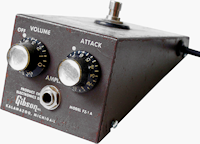There's no electric guitar distortion effect more identified with classic rock than the "fuzz tone". But it actually started with a recording session for a hugely successful country music album.
The origin of the fuzz electric guitar can be traced back to the early 1960s, when a recording engineer named Glenn Snoddy accidentally invented the effect while working on a recording session for the country music artist Marty Robbins.
During the recording session, Snoddy noticed that the guitar riff on Robbins' song "Don't Worry" had an unusual distorted and fuzzy sound. He traced the problem back to a faulty preamp tube in the mixing console, which was causing the guitar signal to overload and create a distorted sound. Rather than replace the faulty tube, Snoddy decided to leave it in and record the distorted guitar sound.

Snoddy later experimented with reproducing this distorted guitar sound using a transistor circuit. He worked with a Nashville-based electronics company called Gibson-Maestro to create the first commercially available fuzz pedal, called the Maestro Fuzz-Tone, which was released in 1962.
The Fuzz-Tone quickly gained popularity among guitarists, particularly in the emerging garage rock and psychedelic rock genres. The distorted and fuzzy sound created by the pedal was unlike anything that had been heard before, and it became an essential tool for many guitarists looking to push the boundaries of rock music.
The success of the Fuzz-Tone led to the development of other fuzz pedals by companies such as Electro-Harmonix and Dallas-Arbiter, and the fuzz effect became a staple of rock music. Today, fuzz pedals are still used by guitarists in a wide range of genres, and the distinctive sound of the fuzz electric guitar remains an important part of rock music history.
